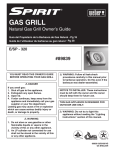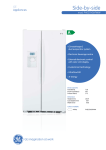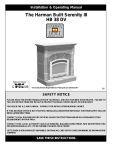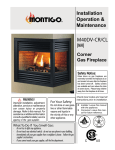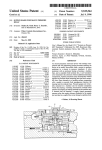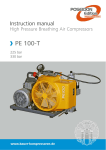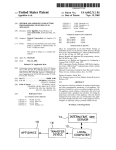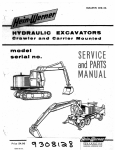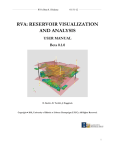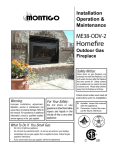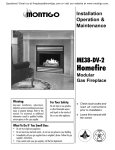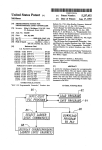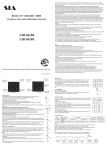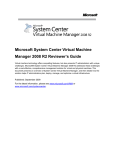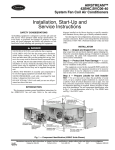Download Small-scale cogeneration system for producing heat and electrical
Transcript
US006053418A United States Patent [19] [11] Patent Number: Guyer [45] Date of Patent: [54] SMALL-SCALE COGENERATION SYSTEM FOR PRODUCING HEAT AND ELECTRICAL 5,544,645 5,727,396 POWER 6,053,418 Apr. 25, 2000 8/1996 Armijo et al. ........................ .. 126/101 3/1998 Boyd et al. .......................... .. 62/323.1 OTHER PUBLICATIONS [75] Inventor: Eric C. Guyer, Dover, Mass. Product Brochure from Iron Fireman Manufacturing Co. entitled “Individual Thermostatic Control of Temperature in each Room”, Copr. 1954. “Application, Installation and Service Manual for the [73] Assignee: Yankee Scienti?c, Inc., Med?eld, Mass. SelecTemp Modulating Zone Heating”, from Turbonics, Inc., Appl. No.: 09/070,435 Filed: Apr. 30, 1998 publication date unknown. Primary Examiner—Harold Joyce Assistant Examiner—Derek S. Boles Related US. Application Data Attorney, Agent, or Firm—Cesari and McKenna, LLP [63] Continuation-in-part of application No. 09/007,262, Jan. 14, [57] 1998. A self-powered heating system includes a boiler for gener ating steam, an expander for extracting mechanical and Int. Cl.7 ..................................................... .. B60H 1/02 US. Cl. ........................................................... .. 237/12.1 electrical energy from the steam and a heat exchanger for transferring heat energy from the steam to room air. A fan mounted adjacent to the heat exchanger forces room air to be Field of Search .............................. .. 237/13, 19, 9 R, 237/8 A, 2 R, 2 A, 12.1 [56] References Cited heated past the heat exchanger and through the space being U.S. PATENT DOCUMENTS heated. An electric pump returns condensate from the heat exchanger to the boiler. The mechanical and electrical power 1,551,438 8/1925 Staley .................................... .. 126/101 2,130,894 9/1938 Muir ........ .. 2,596,968 5/1952 Harris et al. 2/1958 2,827,893 3/1958 Ribaudo et al. 2,833,268 3,198,190 5/1958 Warren .................................. .. 126/101 8/1965 Gordon ................................. .. 126/101 60/105 .. ... ... ... ... ... 11/1965 Ray et al. 3,393,515 7/1968 4,061,131 4,124,178 4,210,102 4,298,311 12/1977 11/1978 7/1980 11/1981 4,344,569 Dalin Tabor et al. for operating the fan and pump are provided by the expander. In particular, the expander extracts mechanical energy from the low pressure steam supplied by the boiler to 126/101 2,822,136 3,219,831 ABSTRACT . . . . .. power the fan and includes a magneto for generating an alternating current which may be converted to a direct 237/17 126/101 current for powering the pump. The electrical power gen erated by the magneto is also sufficient to power a steam valve to the expander and a fuel valve regulating fuel ?ow to the burner. In another embodiment, the system includes a .. 237/12.1 .. ..... .. 60/64 Bohanon ..... .. 126/271 Burke ...................................... .. 237/19 Dosmann ............................ .. 122/20 B RitZi ........................................ .. 415/80 high pressure water heater for small-scale cogeneration of heat and electrical power. The high pressure hot water is expanded to obtain mechanical energy for driving a genera tor and, thereby, producing a supply of electrical power. Hot water and steam from the expander are passed through a condenser to transfer heat to a supply of secondary water. The heated secondary water may then be used for space 8/1982 Gardner. 4,369,917 4,418,538 4,437,308 1/1983 12/1983 3/1984 Schnell ................................. .. 237/12.1 Heinrich .... .. 60/646 Fischer .. .. 60/514 4,474,018 10/1984 Teagan .. 4,768,495 5,046,478 9/1988 Zifferer 9/1991 Clawson 5,243,825 9/1993 ...... .. 62/79 heating purposes. 126/101 126/110 R 38 Claims, 7 Drawing Sheets Lin .......................................... .. 62/238 132 144 U.S. Patent Apr. 25,2000 Sheet 1 0f 7 6,053,418 mm? 02K W2.GEF [3/ O \ P or P INF \mow mowmop U.S. Patent Apr. 25,2000 Sheet 2 0f 7 6,053,418 wow v9. MEN v: mvtk: ?rm?(0: [IN/2E mop @ 5182 Ion? .UEN NZ. U.S. Patent 176 ' Apr. 25,2000 Sheet 3 0f 7 CALL FOR HEAT NO YES 6,053,418 UNIT ON STANDBY : 178K.‘ BOILER AT PRESSURE MINIMUM OPERATING I NO sTART BURNER YES i ‘82 184p. OPEN STEAM VALVE START CONDENSATE PUMP ( 186 sTART ELECTRIC MOTOR MAGNETO 0 U TP U T o KAY YES 4 ( II 190 CALL FOR HEAT SATISFIED 194 SHUTDOWN BURNER 196 CLOSE STEAM VALVE WHEN MAGNETO OUTPUT AT MINIMUM FIG. 3 188 I92 CONTINUE BURNER "ON‘l U.S. Patent Apr. 25,2000 Sheet 4 0f 7 6,053,418 wmv omv 6Ew mObqzv m ov o; mmv m3» wow wowmmw U.S. Patent Apr. 25,2000 Sheet 5 0f 7 6,053,418 vmmm 0m ). a]? mmmt HI ’) coI\\m 6Em mvm mmm Nmw m 6,053,418 1 2 SMALL-SCALE COGENERATION SYSTEM FOR PRODUCING HEAT AND ELECTRICAL POWER forced hot air is noW the most Widely used heating system, despite the disadvantage described above. One heating system that combined aspects of both steam heating and forced hot air heating Was the SelecTemp system from Iron Fireman Manufacturing Company. As shoWn in the Application, Installation and Service Manual, the SelecTemp system, Which has not been in production for This application is a continuation-in-part of application Ser. No. 09/007,262, ?led Jan. 14, 1998. FIELD OF THE INVENTION The present invention relates generally to heating systems, and more speci?cally, to a small-scale cogeneration 10 system for providing heat and electrical poWer. BACKGROUND OF THE INVENTION Electrically Operated Furnaces Many commercial buildings as Well as homes are heated 15 many years, included a central steam boiler that provided steam to each of the rooms being heated. A mini heat exchanger and fan combination Was located in each room. Steam from the boiler Was delivered to the heat exchanger and to a small turbine that operated the fan. The steam Was thus utiliZed to poWer the fan and to generate the heat that Was subsequently forced into the room by the small fan. Condensate from each heat exchanger and fan combination drained back to the boiler in a return piping system that Was by forced hot air furnaces. These furnaces typically include separate from the steam supply piping. The condensate Was an oil or gas-?red burner, a heat exchanger, and an air bloWer collected in a common sump at atmospheric pressure and Was returned to the central boiler by a pump. The pump Was or fan. The heat exchanger typically comprises a plurality of passageWays through Which hot combustion gases ?oW. The fan is mounted next to the heat exchanger such that cool air 20 the boiler (e.g., by another small turbine With its oWn steam may be forced past the heat exchanger and heated. The fan, Which is typically poWered by an electric motor, also moves the heated air through the building or home via an arrange ment of ducts leading to the various rooms. An electric thermostat operably connected to the burner and the fan is often used to control the furnace. The thermostat sWitches supply line). Although the SelecTemp system, including the steam-poWered return pump, Was not dependent on electricity, it Was disadvantageous for several reasons. 25 from being operated or producing heat at more ef?cient vacuum steam temperatures and pressures. That is, in order Whenever the temperature at the thermostat falls beloW a into the home. When the temperature at the thermostat exceeds another preselected level, the thermostat shuts the furnace off, thereby suspending the How of heated air. One of the main disadvantages of such furnaces is their dependence on electricity. As described above, such fur to equaliZe the pressure at each heat exchanger and thereby 30 pump to atmospheric pressure, the heat exchangers Were forced to operate at or someWhat above atmospheric pres 35 sure. For boilers manufactured in accordance With the American Society of Mechanical Engineers (ASME) Pres sure Vessel and Boiler Code (Section IV, Heating Boilers), air past the heat exchanger and through the building or home being heated. In addition, electric poWer is often used to moreover, the maximum steam pressure that may be gener ated by such boilers is about 10 psia. Accordingly, the operate the thermostat and to control the burner. For a 40 example, the electric poWer requirement is typically betWeen 0.5 to 1.0 kiloWatts. Annual electric poWer costs for operating such a furnace are in the range of $75 to $150. Furthermore, if the electricity delivered to the furnace is interrupted for Whatever reason, the furnace is rendered inoperable. That is, Without electric poWer, the thermostat, the burner and the motor that drives the fan Will not Work, thereby stopping the How of Warm air to the space(s) being heated. ensure the return of condensate to the sump, the SelecTemp system speci?cally required that the condensate pump be vented to atmospheric pressure. By venting the condensate naces generally include an electrically poWered fan to move 100,000 Btu/hour residential forced hot air furnace, for First, the con?guration of multiple heat exchangers in separate rooms and a common sump precluded the system the furnace on (e.g., activates the burner and the fan) preselected level. Operation of the furnace brings Warm air either poWered electrically or by the steam produced from corresponding pressure ratios at the turbines Was relatively loW, and thus the available pressure energy that could be extracted to drive the fans Was extremely limited. Another major disadvantage of the SelecTemp system is that the boiler must be maintained at or near its full Working 45 pressure and temperature in order for the system to provide heat. That is, to achieve condensation at the heat exchangers (Which operated at or someWhat above atmospheric pressure) and thereby heat the rooms, the steam being supplied to the heat exchangers needed to be at least 212 Electric poWer, moreover, is often lost in bliZZards or other cold Weather storms. The concomitant loss of the degrees Fahrenheit and positive pressure (relative to furnace’s heating ability, during such periods When the pressure steam at 212 degrees Fahrenheit, the heat transfer process ceased. Accordingly, the energy used to heat the boiler to generate steam at its operating pressure and temperature, Which Was often substantial due to the large atmospheric). Once the boiler stopped producing positive demands for heat are large, can have serious consequences. For example, if the poWer is disrupted for any length of time, the building or home can become so cold as to be uninhab itable. In addition, the temperature in the building or home may fall beloW freeZing, causing Water pipes to burst. The resulting Water damage can be substantial. In addition to hot air heating systems, many older homes and buildings use a steam heating system. With these 55 mass of most cast iron boilers, Was not available for heating the building. Asigni?cant amount of heat energy supplied by the burner Was thus never realiZed. 60 systems, steam from the boiler is distributed to a series of radiators disposed throughout the building using its oWn and control valve in each room Within the space being heated. These numerous Working parts, Which Were dis pressure energy. HoWever, the cost of steam distribution systems is relatively high compared to modern forced hot air heating systems. Additionally, forced hot air systems can be easily modi?ed to provide both heating and air conditioning. Accordingly, for reasons of economy and convenience, The SelecTemp system Was also relatively complex and expensive to manufacture, install and maintain. In particular, the system included a separate heat exchanger, fan, turbine, 65 persed throughout the building, added to the system’s com plexity and cost. The SelecTemp system further required that steam be provided (typically by 1A1 inch copper tubing) to each room, resulting in signi?cant thermodynamic losses. In 6,053,418 3 4 addition, in order to drain accumulating condensate from tory and a boiler capable of Withstanding the high steam pressures and temperatures demands a system far too large and expensive for practical small-scale installations. The ASME code, moreover, prohibits the practical installation of steam boilers operating at these high pressures in residential settings. Additionally, oWners of such systems Would be unWilling to provide the needed supervision to ensure safe operation. Indeed, there is no system presently available for providing safe and economical delivery of electrical poWer these lines, steam traps Were required, Which Were prone to leakage, thereby causing additional problems. The SelecTemp system also did not lend itself to easy installation in existing homes as a replacement furnace, especially for forced hot-air furnaces. That is, the system Was typically a completely neW installation requiring sub stantial construction Work to provide steam pipes running from the boiler to the heat exchanger/fan combination in and heat on a small-scale (i.e., on the order of 2 to 20 each room. Thus, one could not readily convert an existing, kiloWatts) using a high pressure steam boiler. Indeed, no other means of routinely generating both heat and electrical conventional forced hot-air furnace to the SelecTemp sys tem. US. Pat. No. 4,418,538 represents an improvement over the SelecTemp system. This system includes a fuel burner ?red vapor generator, a turbine, and a condenser. The improvement relates to a mechanism for using vapor pres sure Within the system to activate a starting valve for poWer on a small-scale, such as internal combustion engines, has been Widely adopted due to cost and operating difficul 15 ties. SUMMARY OF THE INVENTION It is an object of the present invention to provide a releasing vapor (e.g., steam) to the turbine. More speci?cally, a mechanical valve betWeen the vapor supply self-poWered, forced air, central space heating system that does not require electricity. and the turbine does not open until an adequate vapor pressure to operate the turbine is attained. Since the turbine poWers a fan Which bloWs cool air over the condenser, the efficient, self-poWered heating system that is less costly to It is a further object of the present invention to provide an release of vapor Within the system, including the condenser, before the turbine can poWer the fan could cause the condenser to overheat. This improvement, hoWever, adds considerable complexity and cost to the system and, therefore, fails to represent an affordable self-poWered forced hot air heating solution. The system also fails to include any mechanism for air cooling and/or dehumidi? cation (i.e., air conditioning), even though the vast majority of today’s central air space conditioning systems are imple mented With both heating and cooling function. Heat and Electrical PoWer Cogeneration Systems The use of large-scale steam-poWered stations for the 25 install and maintain than the prior art systems. It is a further object of the present invention to provide a small-scale system for cogenerating heat and electrical poWer for residential or small commercial uses. Brie?y, the invention relates to a self-poWered heating system including a boiler for generating steam, an expander for extracting mechanical and electrical energy from the steam and a heat exchanger for transferring heat energy from the steam to room air. The boiler preferably includes a burner extending at least partially therein. Steam from the boiler is supplied to the expander and the heat exchanger 35 cogeneration of heat and electric poWer are also knoWn. Which are preferably Within the same housing as the boiler or at least disposed in close proximity thereto. A fan or for providing several megaWatts of electrical poWer. This bloWer mounted adjacent to the heat exchanger forces room air to be heated past the heat exchanger and through the space being heated. An electric pump returns condensate from the heat exchanger to the boiler. Signi?cantly, the mechanical and electrical poWer for operating the fan and poWer may then be supplied to a public poWer grid or Within pump are provided by the expander. In particular, the a campus of buildings. The high pressure/high temperature expander receives loW pressure steam from the boiler and expands it to a pressure preferably beloW atmospheric thereby extracting suf?cient mechanical energy to poWer the fan. The expander further includes a magneto for generating Many centraliZed poWer production facilities, for example, burn coal or oil to generate high pressure/high temperature steam Which, in turn, is used to run one or more generators steam may also be used for space heating purposes. That is, remaining heat energy from the steam, after poWering the electric generator(s), may also be provided to neighboring 45 buildings. The steam may then be used for space heating purposes Within the buildings. These large-scale systems (i.e., on the order of several megaWatts) typically operate on the Well-known Rankine current for poWering the pump. The electrical poWer gen erated by the magneto is also sufficient to poWer a steam valve to the expander and a fuel valve regulating fuel How steam cycle. To achieve acceptable fuel efficiency levels, to the burner. Accordingly, the forced hot air heating system steam boiler producing steam at high pressures (e.g., on the over 500 pounds per square inch) are required. These boilers typically include a relatively large free surface area for of the present invention is not dependent upon an external supply of electrical poWer in order to provide heat from a central source. Instead, the system operates solely on the separating the vapor phase (i.e., steam) from the liquid phase (i.e., Water), generating a large inventory of high pressure an alternating current Which may be converted to a direct 55 high temperature Water Within the boiler. In addition, com plex control systems and heavy Wall construction boilers are needed to safely manage the steam. Accordingly, the result temperature at a thermostat falls beloW a selected level, thereby activating the burner and causing the boiler to generate steam. The steam poWers the expander Which, in turn, drives the fan and operates the magneto. Steam exhausted from the expander is condensed in the heat ing systems are typically quite large in siZe and demand constant supervision to ensure safe operation. Indeed, an explosion at theses pressures and temperatures can be cata exchanger in order to heat room air being forced across the strophic. Although these systems are adequate for large-scale operation, they are not suitable for use in most residential or small commercial buildings Where the electric poWer requirements are on the order of 1 to 20 kiloWatts. First, the need for a large vapor/liquid surface area and Water inven loW-pressure steam provided from the boiler. During operation, a call for heat is provided When the 65 heat exchanger by the fan, Which also delivers the Warm air throughout the building via an arrangement of ducts. Con densate exiting the heat exchanger is then returned to the boiler by the pump. When the temperature at the thermostat exceeds another preselected level, the burner is deactivated, eventually suspending the delivery of Warm air. 6,053,418 6 5 Signi?cantly, the operating ?uid (i.e., Water and steam) is FIG. 7 is a block diagram of yet another embodiment of a small-scale cogeneration system. sealed from the atmosphere. Accordingly, at any point in the system, steam pressures above and below atmospheric pres sure (i.e., vacuum pressure) may be present. The ability to DESCRIPTION OF THE PREFERRED EMBODIMENT operate over a range of pressures including vacuum pressures, moreover, permits the generation of sufficient FIG. 1 illustrates a self-poWered heating system 100 in accordance With the present invention. The heating system mechanical energy to poWer a central fan or bloWer and sufficient electrical poWer to operate a pump and other electric components, unlike the prior art systems. In addition, the boiler is capable of generating useful steam for 10 operating the expander and delivering heat to the building provided by a gas line 108 and regulated by a fuel valve 109, Which may be activated by a controller 106. Nonetheless, it should be understood that alternative fuels may also be used. even after the burner is deactivated and the boiler begins to cool doWn. The system may also be used to provide air conditioning. In particular, the fan may force air to be cooled past an 15 evaporator coil. PoWer to operate the fan during air condi tioning may be provided by an electric motor running off of the local electric grid. Additionally, the system may heat a domestic hot Water supply. In this embodiment, steam generated by the boiler may be selectively provided to a coil disposed Within a hot Water supply tank. By circulating steam through the coil, the Water in the tank may be heated. Hot Water may then be draWn out of the tank and replaced With cold Water. Steam or condensate exiting the coil is then returned to the boiler. The invention further relates to a small-scale cogeneration system. In this embodiment, a high pressure Water heater is utiliZed instead of a steam boiler. In particular, the system Exhaust products resulting from the combustion of fuel by 110. Steam generated by the boiler 102 preferably exits via a supply line 112. The steam supply line 112 is connected to an expander 114 and then to a steam condensing heat exchanger 116. A return line 118 carries condensate exiting the heat exchanger 116 back to the boiler 102 through a condensate pump 120. Lines 112 and 118, together With 25 governs the How of steam from the boiler 102, through the expander 114, and to the condenser 116. The expander 114 is used to poWer a central fan or bloWer saturation or boiling point. The hot, high pressure Water is 122 having an exhaust adjacent to the heat exchanger 116. The expander 114 may be operably connected to the fan 122 then provided to an expander Which extracts mechanical energy in order to run a generator. Steam and hot Water via a ?rst endless belt 124a such that rotation of the 35 for forcing room air past the condenser so that it may be ing steam pressure energy to mechanical poWer, such as a reciprocating piston engine, turbine, or rotary vane “motor”. For the typical installation of system 100 (e.g., a residential or small commercial building), expander 114 preferably produces approximate 0.75 kW of poWer to drive the fan 122. A suitable expander for use in the present invention tor. In another embodiment, the condenser includes an outer jacket having a continuous passageWay formed therein. A second Water supply that is segregated from the high pres sure Water ?oWing through the heater and expander is may be of a design similar to that of a conventional rotary 45 122 by a second endless belt 124b. Operation of the electric motor 152 is governed by the controller 106, as discussed beloW. BRIEF DESCRIPTION OF THE DRAWINGS The above and further advantages of the invention may be better understood by referring to the folloWing description in conjunction With the accompanying draWings, in Which: It should be understood that other means besides an arrangement of endless belts 124a, 124b may be used to supply poWer from the expander 114 or motor 152 to the fan FIG. 1 is a block diagram of a self-poWered heating 55 122. For example, a series of gears, a direct shaft coupler, or an electric generator/motor set may be used to transmit poWer from the expander 114 to the fan 122. The boiler 102, moreover, is preferably built to the standards of the ASME Pressure Vessel and Boiler Code Section IV. The boiler 102, expander 114, heat exchanger 116, pump FIG. 4 is a block diagram of a small-scale cogeneration 120 and fan 122 are all preferably disposed Within a single housing 126. The housing 126 includes an air inlet 128 for system for providing heat and electrical poWer in accordance With the present invention; receiving room air to be heated and an air outlet 130. The air outlet 130, in turn, is connected to an arrangement of ducts FIG. 5 is a block diagram of another embodiment of a FIG. 6 is a block diagram of still another embodiment of a small-scale cogeneration system; and sliding vane motor operated With compressed air, especially those designed to operate With no lubrication. Such a com pressed air motor Would need to be converted to operate on steam. An electric motor 152 may be connected to the fan passageWay is heated. This heated secondary Water is then available for space heating purposes. small-scale cogeneration system; expander 114 under the supply of steam from the boiler 102 drives the fan 122. The expander 114 can be any type of positive displacement or turbo-dynamic device for convert heated. The fan is poWered by the electrical energy supplied by the generator. Condensate exiting the condenser is returned to the pump, Which is also poWered by the genera system in accordance With the present invention; FIG. 2 is a partial block diagram of the expander of FIG. 1, illustrating the magneto and mechanical drive compo nents; FIG. 3 is a flow chart of the operating logic of the heating system of FIG. 1; expander 114, heat exchanger 116 and pump 120, represent the circulation path for the Working ?uid (e.g., Water-steam) utiliZed by the heating system 100. An electrically operated valve 154, moveable betWeen an open and a closed position, pressure Water to the heater Where it is heated to near its pumped through the passageWay in the jacket. As vapor condenses in the condenser, the Water ?oWing through the The controller 106 is connected to a thermostat 148 Which may be located Within a room in the space being heated. the burner 104 are preferably disposed via an exhaust stack includes a high pressure Water pump Which provides high exiting the expander is then provided to a condenser. A fan or bloWer is preferably mounted proximate to the condenser 100 includes a boiler 102 for generating steam. Extending into the boiler 102 is a burner 104. The burner 104 prefer ably burns a gaseous hydrocarbon fuel Which may be 65 (not shoWn) Which lead to one or more of the various rooms of the space being heated. Accordingly, the entire heating system 100 (not including the ducts) may be located in a 6,053,418 7 8 single room (e.g., the basement) of the space being heated, starts the condensate pump 120, as indicated by blocks 182 and 184, respectively. Upon reaching the expander 114, the unlike to the prior art SelecTemp system. FIG. 2 is a partial block diagram of the expander 114, Which includes a magneto 162 for generating loW output (e. g., typically less than 50 Watts) alternating current With an steam causes the expander 114 to spin. Rotation of the expander 114 drives the fan 122 via endless belt 124a, causing cool air to be draWn into the housing 126 through unregulated frequency. More speci?cally, the expander 114 the air inlet 128 as shoWn by arroW A. Rotation of the includes a rotating shaft 164 poWered by the loW pressure expander 114 also causes the magneto 162 (FIG. 2) to steam entering the turbine at supply line 112a. At a ?rst end 164a of the shaft 164 is a drive belt pulley 166 for operating the fan 122 (FIG. 1) via endless belt 124a. Mounted to a generate alternating current Which is received at the con troller 106 and converted to direct current poWer. Due to the extraction of mechanical energy, the outlet steam pressure at the expander 114 is loWer than the inlet 10 second end 164b of the shaft 164 opposite the pulley 166 is an armature 168 having an outer periphery 168a. A pair of steam pressure. After leaving the expander 114, the loWer oppositely aligned permanent magnets 170 are preferably pressure steam ?oWs to the heat exchanger 116. The heat disposed Within the outer periphery 168a of the armature 168. In addition to the magnets 170, the magneto 162 also exchanger 116 may comprise a netWork of closely spaced 15 includes at least one stator coil 172 that may be mounted to 120 (i.e., the circulation path), are preferably hermetically sealed and the heat exchanger 116 is preferably con?gured the expander 114 and is thus ?xed relative to the rotating magnets 170. The stator coil 172 is preferably positioned so that the magnets 170 pass in close proximity to the coil 172 during rotation of the armature 168, thereby generating an alternate current Within the coil 172. The alternating current produced by the coil 172 of the magneto 162 is provided to to run at vacuum steam pressure (relative to atmospheric pressure). For example, heat exchanger 116 may operate (i.e., condense steam) at steam pressures beloW 14.7 psia, the controller 106 (FIG. 1) via leads 174. The controller 106, moreover, includes conventional circuitry for converting the alternating current to direct current for operation of the controller 106, the condensate pump 120, steam valve 154, 25 and burner fuel valve 109. Since the total poWer demand for these several control loads can be less than 50 Watts, it is Well Within the poWer capability of the magneto 162. Mag Which is the standard value for atmospheric pressure. As cool air is forced past the tubes of the heat exchanger 116 by fan 122, it is heated. The heated air is then forced, again under operation of the fan 122, through the air outlet 130 as shoWn by arroW B and into at least some of the various rooms of the space being heated. Heat transfer occurring at the heat exchanger 116 causes the steam disposed therein to condense. The condensate exiting the heat exchanger 116 is then returned to the boiler 102. The pump 120, Which is coupled to the return line 118, forces loW pressure condensate exiting heat exchanger 116 netos of similar design are commonly used With internal combustion engines for generating loW levels of electric poWer to operate ignition systems, lights, and other electrical controls and devices. The design and manufacture of such magnetos is Well knoWn and Will not be discussed herein. FIG. 3 is a How chart of the operating logic of the system 100. In operation, When the temperature at the thermostat holloW tubes through Which the steam ?oWs and condenses. The boiler 102, supply line 112, return line 118 and pump 35 back to the higher pressure boiler 102, completing the cycle of the Working ?uid. During operation, the controller 106 monitors the output of the magneto 162, as indicated by block 186 (FIG. 3). If 148 (FIG. 1) falls beloW a preselected level, it issues a call the output of the magneto 162 falls beloW a prescribed level for heat message, as indicated by block 176. In response, the controller 106, at block 178, determines Whether the boiler 102 is already at its operating pressure via a pressure sensor (indicating a possible malfunction in Which the expander 114 may not have suf?cient output to drive the fan 122), the controller 106 starts the electric motor 152, as shoWn by block 188. When the temperature at the thermostat rises above a preselected level, it issues another message indicat 160 (FIG. 1) extending into the boiler 102. Assuming the pressure in the boiler 102 is beloW the minimum operating pressure (e.g., a cold start), controller 106 activates the burner 104, as shoWn at block 180. During periods of normal availability of local grid poWer, the controller 106 accesses such poWer through a poWer line 155 (FIG. 1) to start the system 100. A battery 150 (FIG. 1), connected to the controller 106, is also provided for starting the system 100 during periods of electric poWer interruption. The controller 106 includes conventional circuitry for recharging the bat tery 150 using the electrical poWer from the magneto 162 (FIG. 2). Thus, the system 100 can continue to operate through an inde?nite number of operating cycles, While local grid poWer is interrupted. When local grid poWer is available, the battery 150 is preferably maintained at charge by conventional recharging circuitry Within the controller 106 and, so as not to cause an undue cycling of the battery 150, a small amount of grid poWer is preferably used by the controller 106 to start the system 100. Activation of the burner 104 causes Water in the boiler 102 to be heated, thereby producing steam Which exits the boiler 102 through the supply line 112. The boiler 102 preferably generates steam at an operating pressure of 7 to 15 psig. The controller 106 preferably maintains the valve 154 in a closed position until the boiler 102 has reached a steam pressure that is sufficient to operate the expander 114, at Which point the controller 106 opens the valve 154 and ing that the previous call for heat has been satis?ed, as indicated by block 190. Until the call for heat satis?ed 45 message is sent, controller 106 continues to run the burner 104, as needed, in order to maintain operating steam pressure, as shoWn by block 192. In response to the call for heat satis?ed message, the controller 106 closes the fuel valve 109 deactivating the burner 104, as indicated by block 194. With the burner 104 deactivated, the boiler 102 begins to cool doWn. Nonetheless, even as it cools doWn, the boiler 102 Will continue to produce steam and the valve 154 is kept open, 55 although the pressure of the steam being produced at this point Will be less than the maximum operating pressure of the boiler 102. This loWer pressure steam is still provided to the expander 114 and heat exchanger 116, as described above. Since the expander 114 is able to expand the steam to pressures beloW atmospheric through the closed nature of the circulation path, the expander 114 is still able to extract suf?cient energy from this loWer pressure steam to drive the fan 122 and operate the magneto 162. Similarly, the steam exiting the expander 114 Will still have sufficient pressure and temperature to alloW the heat exchanger 116 to heat 65 room air. For example, heat exchanger 116 is preferably con?gured to condense steam at a saturation pressure of at least as loW 6,053,418 9 10 as 7 psia. The condensing temperature of steam at 7 psia, moreover, is approximately 175° F. Assuming return air from the building enters the heat exchanger at approximately 70° F., a suf?cient temperature differential still exists to heat room air to 140° E, which is the desired operating tempera ture. Expander 114 is also con?gured to poWer the fan 122 to generate steam that is then supplied to the coil 134. Similarly, the controller 106 may de-activate the burner 104, thereby suspending the How of steam to the coil 134. As set forth herein, the present invention is a completely self-poWered, space heating system requiring no outside electrical poWer. That is, the system 100 Will continue to produce heat despite a loss of electrical poWer to the home or building being heated. The system 100 also provides a Whenever the pressure being produced by the boiler is above the minimum saturation pressure for useful operation of the supply of hot Water, again Without relying on electricity. heat exchanger (e.g., 7 psia). As a result, continued heating may take place even though the burner 104 has been deactivated. In fact, the system 100 may continue to provide heat transfer until the pressure at the heat exchanger 116 falls 10 system 100 alloWs for operation With vacuum steam beloW approximately 3 psia. pressures, thereby signi?cantly increasing the poWer output At some point, the steam exiting the boiler 102 Will not have suf?cient pressure to drive the expander 114 or con 15 dense Within the heat exchanger 116, stopping the How of Warm air to the space being heated. Further cooling of the of the system, the pressure in the boiler and the heat exchanger may both be above atmospheric pressure, both be beloW atmospheric pressure, or in a state Where the pressure in the boiler is above atmospheric While the pressure in the heat exchanger is beloW atmospheric pressure. The use of a vacuum heat exchanger 116 speci?cally 25 Referring to FIG. 1, the system 100 also includes an air conditioning evaporator coil 151 as is customary With forced air central space conditioning systems. The evaporator coil 151 is preferably disposed Within the air outlet 130 doWn stream of the condenser 116. The evaporator coil 151 carries heating system (e.g., a central fan). That is, as previously mentioned, heat exchanger 116 is preferably con?gured to provide steam condensation at pressures beloW atmospheric pressure. Also, since the heat exchanger 116 and the expander 114 are all preferably located in close proximity to the boiler 102 (e.g., Within the single housing 126), the 35 evaporator coil 151. The controller 106 may use poWer from thermal losses experienced With the prior art systems are avoided and installation and maintenance is simpli?ed. The system 100 may also be readily installed as a replacement system in buildings With preexisting forced hot-air furnaces, the local grid to operate motor 152. To improve ef?ciency, since the system 100 can utiliZe the existing arrangement of ducts. both the electric motor 152 and the steam expander 114 preferably include conventional overrunning clutches (not The system 100 also has the advantage of utiliZing shoWn) to prevent unnecessary rotation and poWer consump tion When the corresponding component is not in use. The system 100 may also be used to produce a supply of hot Water. Here, a separate feed pipe 132 is connected to the supply line 112 carrying steam from the boiler 102. The feed pipe 132 provides steam to a heating coil 134 disposed practical and reliable electric poWer controls and compo nents to achieve ef?cient system operation. For example, the electric motor 152, in addition to operating the fan 122 for air cooling and dehumidi?cation, also provides a back-up poWer drive for the fan 122 during the heating season. Thus, during the vast majority of the year When electric poWer is available from the local grid, any failure of the expander 114 or the drive belt 124a can be automatically compensated by inside a hot Water tank 136. A return pipe 138 transfers condensate exiting the heating coil 134 to the boiler 102. Water to be heated is provided to the tank 136 via an inlet 140. As Water in the tank 136 ?oWs around the coil 134, it is heated. Hot Water may then be draWn out of the tank 136 via an outlet 142. Asteam valve 144 may be disposed in the feed pipe 132 to shut off or adjust the How of steam being provided to the coil 134 in the tank 136. The controller 106 may be utiliZed to adjust and/or maintain the temperature of the Water in the tank 136. In particular, the controller 106 may be operably connected to the valve 144 and a temperature sensor 146 disposed Within the tank 136. When the temperature of the Water in the tank 136 falls beloW a preset value, the controller 106 preferably makes feasible the con?guration of the system 100 Wherein the steam from a loW pressure boiler 102 can produce enough mechanical poWer to operate a central forced air ef?cient than prior designs. coolant supplied by conventional air conditioning compo nents (not shoWn) connected to the coil 151. The controller 106 provides for operation of the fan 122 through electric motor 152 for air cooling and dehumidi?cation by the of the expander 114. As a result, the available poWer of present system 100 is about double that of the prior art SelecTemp system for the same air heating temperature condition. Furthermore, at different times during operation boiler 102, moreover, Will suspend the production of steam entirely. As indicated by block 196, When the output of the magneto 162 drops beloW a prescribed level, the controller 106 preferably closes the steam valve 154. Nonetheless, as shoWn, the present system 100 is able to extract a signi?cant portion of the heat energy used to heat the boiler to its operating temperatures and pressures and use this energy to heat the corresponding space. System 100 is thus much more Furthermore, as shoWn in the illustrative embodiment of FIG. 1, the system 100 requires feW parts and is substantially re?ned and improved over the prior art systems. Notably, the sWitching to the electric motor 152 to drive the fan 122. Also, should the magneto 162 fail to generate suf?cient poWer for operation of the pump 120 When local grid poWer is available, the controller 106 preferably includes conven tional circuitry to sWitch to local grid poWer as a back-up. The mechanical decoupling of the feed pump 120 from 55 the expander 114 also provides important operational advan tages in comparison to prior art systems. For example, the pump 120 can be started before opening steam valve 154 in order to achieve a reduced pressure in the condenser 116. This Will result in a faster startup of the expander 114 to full poWer capacity once the valve 154 is opened. The use of a moves the valve 144 from a closed to an open position, loW-cost, commercially available, electrically actuated valve alloWing steam to How to the coil 134 and heat the Water in tank 136. When the temperature of the Water in the tank 136 mechanical linkages and interlocks as required by the prior 154 also avoids a complicated use of pressure diaphragms, reaches another level, the controller 106 preferably closes the valve 144. It should be understood that the controller 106 may alternatively activate the burner 104, causing the boiler 102 65 art systems. Similarly, the use of the electric fuel valve 109 With a spark burner ignition as opposed to the millivolt thermoelectric fuel valves With standing pilot ?ame of prior art systems increases energy ef?ciency. 6,053,418 11 12 Thus, taken all together, system 100 represents a signi? cant improvement over prior art designs, since it provides redundancy, While preserving the desired feature of sus shoWn by dashed lines 444. As described beloW, controller 440 governs the operation of the cogeneration system 400 and provides supplemental electric poWer to a utility grid (not shoWn) via electric outlet line 444a. Controller 440 is tained operation during electrical poWer outages. System preferably coupled to a thermostat (not shoWn) disposed in 100 also signi?cantly reduces electrical poWer consumption during the heating season. Electric motor 152, moreover, the space being heated. for high heating reliability through operating system provides heating function redundancy and space cooling and dehumidi?cation as needed during summer periods. Also, the system 100 may incorporate a high capacity Water heating component, thus avoiding the need for a separately ?red Water heater, Which typically has much loWer heating poWer rating than boiler 102. Additionally, the system 100 is more ideally con?gured to take advantage of loW-cost 10 In response to a call for heat from the thermostat, the controller 440 activates the combustion fan 414 and the pump 438 and opens the fuel valve 412. To perform these functions, controller 440 may utiliZe a small amount of poWer from the electric utility grid via line 444a. If electric poWer is unavailable (e.g., during a poWer outage), control ler 440 may utiliZe electric poWer stored in the battery 442 to start the system 400, as described above. Fuel entering the of electric poWer is not completely abandoned. Speci?cally, burner 408 is ignited thereby heating the high pressure Water disposed in the heating element 406 of heater 404. Burner the system 100 is amenable to the use of various electronic 408, combustion fan 414 and heater 404 are all preferably electronic controls than the prior art systems, since the use 15 display lights and indicators commonly used in modern con?gured so as to heat the Water in element 406 to a appliances. temperature near the boiling point for the corresponding operating pressure (e.g., 467 F° at 500 psia). High pressure, FIG. 4 is a block diagram of a small-scale cogeneration system 400 in accordance With the present invention. The cogeneration system 400 includes a high pressure heater 404 (as opposed to a loW pressure boiler). Disposed Within the heater 404 is a heating element 406 through Which a ?uid, such as Water, ?oWs at high pressure. Heating element 406 is preferably formed from a small diameter helical coil having ?ns to improve heat transfer. Aburner 408 extends at least partially into the heater 404. Burner 408 preferably hot Water exits the heater 404 at supply line 418 and enters the expander 420 Which extracts mechanical energy from the high pressure, hot Water, thereby reducing the pressure (e. g., 25 to 7 psia) and causing at least a portion thereof to be ?ashed to steam. Mechanical energy extracted by expander 420 is used to drive the generator 422. That is, the expander 420 is preferably coupled to the generator 422 by suitable means (e.g., a drive shaft, belt, etc.) so as to run the generator 422. operates on a gaseous hydrocarbon fuel Which may be Operation of the generator 422 by the expander 420 results provided by a gas line 410 and regulated by a fuel valve 412. Combustion air may be provided under pressure to burner in a supply of electrical poWer Which is provided to the controller 440. Once the controller 440 begins to receive electrical poWer from the generator 422, it no longer needs to rely on the electric utility grid or the battery 442 to operate the system 400. The expander 420 can be of a positive displacement or 408 by a combustion air fan 414 Which also forces com bustion gases through the heater 404 and into an exhaust stack 416. It should be understood that the burner 408 may also operate under natural draft conditions. Heating element 406 of heater 404 is preferably con nected to an expander 420 by means of a supply line 418 so that high pressure, hot Water may ?oW from element 406 to 35 turbo-dynamic device design for converting high pressure, hot Water to mechanical poWer, such as a rotary vane or screW motor similar to that described in US. Pat. No. 4,437,308 entitled Rotary Heat Engine the speci?cation of Which is hereby incorporated by reference in its entirety or the expander 420. The expander 420, in turn, is operably coupled to a generator 422. Hot Water and/or steam exiting the expander 420 preferably passes through a three-Way a turbine similar to that described in US. Pat. No. 4,298,311 valve 424 and is delivered to a condenser 426. A central air entitled TWo-Phase Reaction Turbine the speci?cation of bloWer 428 is preferably disposed adjacent to the condenser 426. The heater 404, expander 420, generator 422, con Which is hereby incorporated by reference in its entirety. denser 426 and bloWer 428 are all preferably mounted Within a housing 402 having an air inlet 402a and an air outlet 402b. In particular, the central air bloWer 428 and the Since a portion of the high pressure, hot Water Will ?ash to 45 Hot Water and steam exiting the expander 420 is then provided to the condenser 26 and is condensed in order to heat room air being forced past the condenser 426 by the condenser 426 are preferably arranged Within the housing 402 so that the bloWer 428 may draW cool room air into the bloWer 428. In particular, the controller 440, utiliZing elec housing 402 via air inlet 402a and force it past the heat exchanger 426 and out the air outlet 402b. The air outlet 402b, moreover, is preferably connected to an arrangement of ducts (not shoWn) Which lead to one or more of the various rooms of the space being heated. The central air bloWer 428 may be poWered by an electric motor 430 Which team during expansion, the expander should be capable of operating under tWo-phase loW (i.e., Water and steam). tric poWer from generator 422, activates the bloWer motor 430 Which, in turn, runs the bloWer 428. Operation of the bloWer 428 draWs room air into the air inlet 402a and forces it past the heat exchanger 426 heating it. Warm room air is 55 is operably coupled thereto (e.g., by endless belt 432). then distributed throughout the space being heated by the ducts coupled to the air outlet 402b. Condensate exiting the heat exchanger 426 ?oWs back to the heater 404 via return line 434. Pump 436 preferably maintains the Water pressure Areturn line 434 connects the condenser 426 to the heater 404 so that condensate exiting the condenser 426 may be returned to the Water heater 404. Ahigh-pressure pump 436, in the heater 404 at the desired value (e.g., 500 psia). As shoWn, cogeneration system 400 is capable of supply preferably disposed Within the return line 418, maintains the Water in the heater 404 at a high pressure, (e.g., in excess of ing both heat and electric poWer on a small-scale (e. g., on the 100 psia). The pump 436 is preferably poWered by an order of 1 to 20 kilowatts). In other Words, by utiliZing high electric pump motor 438. The cogeneration system 400 pressure, hot Water, system 400 is able to generate excess electrical poWer beyond the needs of the electrical compo nents included therein. This excess electrical poWer may be further includes a controller 440 that is coupled to the generator 422 for receiving electrical poWer therefrom. The controller 440 is also operatively connected to the valve 424, electric motor 430, pump motor 438 and a battery 442, as 65 utiliZed by the corresponding home or building and/or supplied to the corresponding electrical poWer grid. To 6,053,418 14 13 Condensate exiting the coil 528 of the heat exchanger 526 improve efficiency, a portion of the exhaust stack 416 may be positioned proximate to the air inlet 402a so as to preheat the room air entering the heating system 400. The controller ?oWs back to the Water heater 504 through a return line 534. A high pressure pump 536, preferably disposed Within the return line 534, maintains the Water ?oWing through element 440, moreover, may be con?gured to recharge the battery 442 While electrical poWer is being supplied by the generator 506 of heater 504 at a high pressure (e.g., in excess of 100 psia). Pump 536 is preferably poWered by an electric pump 422. The cogeneration system 400 may also be con?gured to motor 538. A controller 540 is operably connected to the heat a domestic supply of Water With a portion of the hot Water and steam exiting the expander 420. In particular, a feed pipe 446 may be connected to the valve 424 so as to divert some or all of the Water or steam exiting the expander 420 to a heating coil 448 disposed in a hot Water tank 450. generator 522, valve 524, secondary Water pump 532, high pressure pump motor 538 and a battery 542, as shoWn by dashed lines 544. As described beloW, controller 540 gov erns the operation of the cogeneration system 500 and provides electric poWer to the corresponding home or build A return pipe 452 transfers condensate exiting the heating coil 448 to the return line 434. Water to be heated is provided to the tank 450 via an inlet 454. As Water in the tank 450 ?oWs around the coil 448, it is heated. Hot Water may then be draWn out of the tank 450 via an outlet 456. The valve ing via electric outlet line 544a. Controller 540 is preferably coupled to a thermostat (not shoWn) disposed in the space 15 During operation, controller 540 activates combustion fan 514 and pump motor 538 and opens the fuel valve 512. As described above With reference to FIG. 4, the controller 540 may obtain the necessary electrical poWer from the battery 542 or the electric utility grid via line 544a. Water heater 424, Which may be electrically activated, preferably adjusts the How of hot Water and steam being provided to the coil 448 under the command of controller 440. It should be understood that, for a given pressure, the ef?ciency With Which mechanical energy may be extracted from steam is greater than the ef?ciency With Which mechanical energy may be extracted from hot Water. As described above, hoWever, a cogeneration system utiliZing high pressure steam (e.g., above 100 psia) Would be extremely expensive and present signi?cant risk of injury being heated. 504, burner 508 and element 506 are similarly con?gured to heat the high pressure Water to a temperature near the boiling point for the corresponding operating pressure (e.g., 500 25 should a failure occur. Nonetheless, the ef?ciency With Which mechanical energy can be extracted from high pressure, hot Water is suf?cient for operating a small-scale psia). High pressure, hot Water exits the heater 504 at supply line 518 and enters the expander 520, causing it to spin and run the generator 522. Again, the expander 520 is coupled to the generator 522 by suitable means, e.g., a drive shaft, belt, etc. Electrical poWer from the generator 522 is provided to cogeneration system. For example, the thermodynamic ef? the controller 540. Hot Water and steam exiting the expander 520 is then ciency of a tWo phase (Water and steam) system having a 500 psia heater and a 7 psia heat condenser is nearly tWo-thirds of the ef?ciency of a steam cycle system operating at the provided to the heat exchanger 526 and ?oWs through the condensing coil 528 heating the Water disposed in Water chamber 530. The controller 540, utiliZing electric poWer same pressures. Accordingly, a high pressure Water system, as described above, although slightly less ef?cient than a supplied by the generator 522, also activates the secondary 35 steam cycle system can be economically designed and manufactured and is far safer to operate than high pressure steam systems. FIG. 5 is a block diagram of another small-scale cogen disposed Within the building. Condensate exiting the coil 528 ?oWs back to the Water heater 504 via return line 534. Secondary Water pump 536 maintains the Water pressure in eration system 500. System 500 similarly produces a supply the heater 504 at the desired high operating pressure (e.g., 500 psia). It should be understood that the Water supply ?oWing through the Water heater 504, expander 520 and coil of electrical poWer as described With reference to FIG. 4, but also provides a supply of hot Water (as opposed to forced hot air) for use in heating the corresponding space. Speci?cally, the cogeneration system 500 includes a Water heater 504 having a high pressure heating element 506 and a burner 508 extending therein. A gas line 510 provides fuel as regulated by a fuel valve 512 to the burner 508. An electrically poWered combustion air fan 514 supplies combustion air to the burner 508 and forces combustion gases through heater Water pump 532, Which, in turn, forces cool Water into the chamber 530 and drives heated Water from the Water cham ber 530 and into the radiators or other heat transfer devices 528 is completely separate from the Water supply ?oWing 45 through the Water chamber 530 and the radiators. Similar to system 400 of FIG. 4, the cogeneration system 500 may also be con?gured to heat a domestic supply of Water. Speci?cally, a feed pipe 546 may be connected to the valve 524 so as to divert some or all of the Water or steam 504 and into an exhaust stack 516. exiting the expander 520 to a Water tank coil 548 disposed High pressure, hot Water exits the heating element 506 through a supply line 518 and is provided to an expander 520, Which is operably coupled to a generator 522. Hot Water and/or steam exiting the expander 520 passes through a in a hot Water tank 550. A return pipe 552 transfers con three-Way, electrically operated, valve 524 and is delivered densate exiting the tank coil 548 to the return line 534. Water to be heated is provided to the tank 550 via an inlet 554 and heated Water may be draWn out of the tank 550 through an 55 to a heat exchanger 526. The heat exchanger 526 includes a Water chamber 530 and a condensing coil 528 disposed therein. The Water chamber 530 includes a Water inlet line 530a for receiving Water to be heated and a Water outlet line 530b Which may be connected to a plurality of radiators or FIG. 6 is a block diagram of another embodiment of a small-scale cogeneration system 600. The system 600 includes a heat exchanger 610 having an outer casing 612. other heat transfer devices (not shoWn) disposed Within the space being heated. An electrically driven secondary Water Within the outer casing 612 is one or more interconnected passageWays 614. Disposed inside the heat exchanger 610 is pump 532 may be disposed Within the Water inlet line 530a for forcing Water through the Water chamber 530 and into the corresponding radiators. A series of return Water pipes (not shoWn) convey cooled Water exiting the radiators to the Water inlet line 530a. outlet 556. The valve 424, under operation of the controller 540, preferably adjusts the How of hot Water and steam being provided to the tank coil 548. a high pressure heat transfer element 616, Which may be a 65 holloW coil having outWardly extending ?ns to aid in the heat transfer process. Extending at least partially into the heat exchanger 610 is a burner 618. In particular, the heat transfer element 616 and the burner 618 may be arranged 6,053,418 15 16 Within the heat exchanger 610 so that element 616 surrounds at least a portion of the burner 618. An internal structure 620, having a passageway 622 that is connected to passageways combustion air to the burner 618. The fuel-air mixture formed by burner 618 is ignited, thereby heating the high pressure ?uid ?oWing through element 616. This hot, high 614, may also be provided Within the heat exchanger 610. pressure ?uid exits the heat transfer element 616 and ?oWs Structure 620 may be disposed doWnstream of the heat transfer element 616 relative to the burner 618. As shoWn, a to the expander 626 through line 658. The expander 626 extracts mechanical energy from the plurality of connecting ?ns 624 may be provided betWeen hot, high pressure ?uid so as to rotate shaft 630 and run the the interior surface of the casing 612 and the internal generator 628. As described above, extraction of mechanical energy results in a portion of the hot, high pressure Water structure 620 to further aid in the heat transfer process, as described beloW. 10 In addition to the heat exchanger 610, the system 600 liquid phases of the Working ?uid, Which may be at or beloW atmospheric pressure, enter the condenser 632 via the third line 660. The vapor portion of the Working ?uid condenses further includes an expander 626 and an electric generator 628 that is operatively coupled thereto (e.g., by a drive shaft 630). Acondenser 632 having an outer condenser jacket 634 that de?nes an inner surface 634a may also be provided. Formed Within the condenser jacket 634 is at least one interconnected condenser passageWay 636. A plurality of 15 of electrical poWer is provided Which exceeds the poWer needed to operate the system 600. This excess electrical surface 634a so as to increase the surface area thereof. The 20 for governing the operation of the system 600. Acombustion bloWer 646 may be included for providing pressuriZed 616 via a ?rst high pressure line 654, Which may include a ?oW sWitch 656 for con?rming the ?oW of ?uid. A second high pressure line 658 connects the heat transfer element 616 to the expander 626 so that heated ?uid from element 616 may be provided to the expander 626. A temperature/ building. In addition to providing a supply of electrical poWer, ary Water to be used for local space heating purposes is 25 burner 618. The high pressure pump 640 delivers a poWer generation ?uid (e.g., Water) at a high pressure (e.g., in excess of 100 psia and preferably at 500 psia) to the heat transfer element poWer may be made available to the corresponding home or system 600 also produces heat energy. Speci?cally, second combustion air received via an inlet air pipe 648 to the burner 618. A fuel regulating valve 650 receives fuel (e.g., natural gas) from a fuel supply line 652 and provides it to the on the cooler inner surface 634a of the condenser jacket 634 and collects at the sump 664. This liquid is then provided to the high pressure pump 640 via fourth line 662 so as to complete the cycle. By running the generator 628, a supply inWardly extending posts 638 may be mounted to the inner system 600 further includes a high pressure pump 640, a hydronic Water circulation pump 642 and a controller 644 being ?ashed to vapor (e.g., steam). The resulting vapor and supplied to the system 600 via Water inlet pipe 666. The secondary Water is draWn through the system 600 by the hydronic circulation pump 642 Which is operated by the controller 644. More speci?cally, the secondary Water ini 30 tially ?oWs through passageWays 614 and 622 at the heat exchanger 610. The ?oW of relatively cool secondary Water through the passageWays 614 and 622 serves tWo functions. First, it keeps the heat exchanger 610 from overheating. Second, it improves overall ef?ciency by pre-heating the secondary Water. As the combustion gases from burner 618 35 ?oW past the connecting ?ns 624, useful heat remaining in pressure sensor 660 that is connected to controller 644 may the combustion gases is transferred to the secondary Water be disposed Within second line 658. Another line 660 connects the expander 626 to the interior of the condenser ture 620, thereby extracting additional heat from the com supply ?oWing through passageWays 622 in internal struc 632, While a fourth line 662 connects a sump 664 located at the base of the condenser 632 to the high pressure pump 640, thus de?ning a closed poWer ?uid circulation path. A Water inlet pipe 666 is coupled to the heat exchanger 40 bustion process. Pre-heated secondary Water next ?oWs into the condenser 632. In particular, the secondary Water ?oWs through the passageWays 636 of condenser jacket 634, Which is prefer 610 so as to permit Water to ?oW through the interconnected ably adjacent to or otherWise in heat transfer proximity to the passageWays 614. An intermediary Water pipe 668 to Which tWo-phase Working ?uid. As it circulates through the pas Water pump 642 is mounted connects the passageWays 614 45 sageWays 636, the secondary Water is further heated as a result of the condensing of the vapor and the ?oW of Working ?uid Within the interior of the condenser 632. Preferably, hydronic Water pump 642 circulates secondary Water of the heat exchanger 610 to the condenser passageWays 636. An outlet Water pipe 670 also connects to the condenser passageWays 636. The system 600 may also include a ?ue exhaust 672 extending from the heat exchanger 610. Dis posed Within the ?ue exhaust 672 may be a ?ue condensate trap 674. Athermostat 676 that is connected to the controller 50 through the condenser passageWays 636 at a ?oWrate that maintains the condenser 632 at a temperature beloW 212° F. By keeping the condenser 632 beloW this temperature, a 644 may be provided in the corresponding space being vacuum pressure may be formed Within the condenser 632, heated. In operation, the controller 644 receives a call for heat from the thermostat 676 and, in response, activates the expander 626 and improving its poWer extraction capabili thereby maximizing the pressure differential across the 55 ties. Heated secondary Water exits the condenser 632 through Water outlet pipe 670 and is available for space heating purposes. That is, the heated secondary Water may be delivered to a plurality of forced hot Water radiators (not 60 or to a domestic Water heating component (not shoWn). The controller 644 preferably includes conventional cir cuitry to perform several functions in addition to overall control of the system 600. These additional functions include con?rming the ?oW of Working ?uid from pump 640 before activating the burner 618 and/or fuel valve 650, electrically poWered high pressure pump 640 to Which it is operatively connected. As described, electric poWer for starting the system 600 may come from a battery or the electric poWer grid. The pump 640 provides high pressure ?uid (e.g., Water at approximately 500 psia) to the heat transfer element 616. For a cogeneration system capable of supplying approximately 100,000 Btu/hr. of heat energy, the ?oWrate is around 0.5 gallons/minute. Upon con?rming the ?oW of Water through line 654 by means of the ?oW sWitch 656, the controller activates the burner 618. In particular, controller 644 activates combustion bloWer 646 and operates fuel valve 650, thereby providing fuel and pressuriZed shoWn) dispersed throughout the corresponding space and/ 65 monitoring the temperature and pressure of the Working ?uid being input to the expander 626 (via sensor 660) so as 6,053,418 17 18 to ensure that the system 600 is operating Within its tem of the heat transfer element 714. An internal structure 718, having passageWays 720 that are connected to the dividing Wall passageWays 710, may also be provided. Structure 718 may be disposed doWnstream of the heat transfer element 714 relative to the burner 716. Aplurality of connecting ?ns 722 may extend betWeen the inner surface 708b of the Wall 708 and the internal structure 718. A ?ue exhaust 724 is connected to the heat exchanger section 706 of the inte perature and pressure limits, monitoring the electrical poWer output of the generator 628 and adjusting the operating characteristics of the pump 640, fuel valve 650, burner 618, combustion bloWer 646 and secondary Water pump 642 to meet the particular demands for heat and electrical poWer Within the corresponding space. In particular, by adjusting the operating characteristics of the pump 640, the combus tion air bloWer 646 and/or the fuel valve 650, the controller 644 can regulate the electrical poWer output of the generator 628. Due to the rapid thermal response of the output of heating element 616 to changes in burner ?ring rate and/or grated unit 702 so as to remove combustion gases therefrom. 10 The ?ue exhaust 724 may be coupled to a vent or chimney (not shoWn). The cogeneration system 700 further includes a high Water ?oWrate, the controller 644 may quickly increase or pressure pump 726, an expander 728 and a generator 730. decrease the electrical output of the system 600 by simply changing the pressure generated by pump 640 and/or the 15 by a drive shaft 732 so as to run the generator 730. In The expander 728 is preferably coupled to the generator 730 ?ring rate of the burner 618 addition, the pump 726 is connected to the heat transfer element 714 by a ?rst high pressure line 734. Asecond high The condenser 632 may further include a vent 678 for eliminating air and other non-condensable gases that may be present in the system 600 during start-up or that may accumulate in the system 600 during operation. The vent 678 may be thermostatically or actively operated to remove such gases. Similarly, condensation of Water vapor that may occur in heat exchanger 610 and/or ?ue exhaust 672 during operation of the system 600 may be removed by trap 674. The heat exchanger 610 is preferably formed from an pressure line 736 connects the heat transfer element 714 to the expander 728. A third line 738 connects the expander 728 to the condenser section 704 of the integrated unit 702. A fourth line 737 may connect a sump area 739 of the condenser section 704 of the integrated unit 702. The system 700 may further include a combustion air bloWer 740 for providing pressuriZed combustion air from 25 aluminum casting alloy. Alloys of aluminum, silicon, and magnesium provide optimum material characteristics for the valve 744. A Water inlet pipe 748 connects to the passage Ways 710 of the Wall 708 and/or the passageWays 720 of the manufacture and operation of heat exchanger 610. For example, the aluminum alloy commonly knoWn as 356 is internal structure 718. A hydronic secondary Water pump 750 may be disposed at the Water inlet 748. An outlet Water particularly useful. These alloys provide desirable thermal conductivity, Which is important for achieving high heat transfer performance in a compact design, are lightWeight and generally loW-cost. The alloys can also be readily formed into intricate holloW-section shapes by casting into sand or permanent molds. Furthermore, the alloys have improved resistance to the corrosive effects of acid ?ue condensate Which is often deposited on the surface. Other materials that have traditionally been used in the construc an inlet air pipe 742 to the burner 716. Fuel from a supply line 746 is provided to the burner 716 by a fuel regulating 35 pipe 752 similarly connects to the passageWays 710. Opera tion of the system 700, as described beloW, is preferably governed by a controller 754, operatively connected to the high pressure pump 726, the generator 730, the fuel valve 744, the combustion air bloWer 740 and the hydronic sec ondary Water pump 750. Controller 754 monitors the operation of the cogeneration tion of ?red heaters such as mild or alloy steel, cast iron, or system 700 through a series of sensors coupled thereto. In particular, a How sWitch 756 mounted in the ?rst line 734 copper alloys are generally less efficient in either thermal properties, corrosion resistance, cost, Weight, or ease of fabrication. FIG. 7 is a block diagram of another cogeneration system temperature/pressure sensor 758 located in second line 736 provides additional information to the controller 754. A 700 having an integrated condenser/heat exchanger unit Which has been designated generally 702. The integrated may provide proof-of-?oW signals to the controller 754. A 45 unit 702 includes an outer condenser section 704 and an inner heat exchanger section 706 that are preferably sepa rated by a dividing Wall 708 having one or more intercon nected passageWays 710 formed therein. The dividing Wall 708 includes an outer surface 708a extending along the condenser section 704 and an inner surface 708b extending thermostat 760 located in a space being heated (not shoWn) may provide calls to the cogeneration system 700. The controller 754, Which provides the same functionality as described above With regard to controller 644, may similarly be coupled to the local poWer grid for receiving and/or providing poWer thereto. The operation of cogeneration system 700 is similar to the operation of system 600 (FIG. 6) and, therefore, Will not be along the heat exchanger section 706. A plurality of posts 712 are preferably mounted to and extend aWay from the outer surface 708a of the dividing Wall 708 so as to increase 55 the surface area thereof. The integrated condenser/heat exchanger unit 702 is pref described in detail. In general, high pressure ?uid is pro vided by electrically poWered pump 726 to element 714 in the heat transfer section 706 of the integrated unit 702. The high pressure ?uid is heated to nearly its saturation point by operation of burner 716 and is supplied to the expander 728 Which extracts mechanical energy from this hot, high pres erably formed from an aluminum casting alloy. As described sure ?uid in order to run the generator 730. The tWo phase for heat exchanger 610 (FIG. 6) of system 600, alloys of aluminum, silicon, and magnesium provide optimum mate Working ?uid exiting the expander 732 is then provided to the condensing section 704 of the integrated unit 702 Where rial characteristics for the manufacture and operation of the the vapor portion condenses and is collected at sump 739. Secondary Water for use in heating the corresponding space enters the system 700 at inlet Water pipe 748 and ?oWs through the passageWays 710 and 720 of the dividing Wall 708 and the internal structure 718, respectively. As the Working ?uid condenses in the condenser section 704 heat is integrated condenser/heat exchanger 702. Mounted Within the heat exchanger section 706 is a high pressure heat transfer element 714, Which may be a holloW coil having outWardly extending ?ns. A burner 716 extends at least partially into the heat exchanger section 706. Preferably, the burner 716 extends centrally Within the coil 65 transferred to the secondary Water supply circulating 6,053,418 19 20 an electric generator operatively coupled to the expander, through the passageways 710, 720. This circulation of secondary Water similarly tends to cool the heat exchanger section 706 of the integrated unit 702. Heated secondary Water is then available for space heating and/or domestic Water heating purposes via Water outlet pipe 752. In addition, controller 754 includes conventional circuitry for the generator being poWered by the mechanical energy extracted from the Working ?uid; a condenser connected to the expander for receiving the liquid and vapor phase of the expanded Working ?uid; means for circulating a secondary Water supply in prox imity to the liquid and vapor phase of the expanding Working ?uid alloWing the secondary Water to be heated as the Working ?uid condenses; and monitoring and adjusting the operation of the cogeneration system 700 to ensure that it remains Within acceptable operating limits and produces the requisite heat and electri cal energy demanded by the corresponding space. 10 It should be understood that other arrangements for trans ferring the latent heat of the tWo-phase ?uid exiting the expander to the secondary Water supply may also be utiliZed. The foregoing description has been directed to speci?c embodiments of this invention. It Will be apparent, hoWever, means for returning condensate from the condenser to the Pump, Wherein the condenser includes an outer jacket and the circulating means comprises: at least one passageWay extending inside the jacket; and 15 a secondary Water pump coupled to the at least one passageWay and con?gured to convey secondary Water that other variations and modi?cations may be made to the described embodiments, With the attainment of some or all through the passageWay, of their advantages. Therefore, it is the object of the further Wherein the heat exchanger further includes an outer casing and at least one interconnected passageWay extends appended claims to cover all such variations and modi?ca tions as come Within the true spirit and scope of the through the casing and the cogeneration system further comprises means for circulating secondary Water through invention. What is claimed is: the at least one passageWay of the heat exchanger casing. 3. The cogeneration system of claim 2 further comprising: 1. A small-scale cogeneration system for providing heat and electrical poWer, the system having a Working ?uid, Which may be subjected to a high pressure and heated, and a generator for producing electrical poWer from the energy an inlet Water pipe connected to a ?rst end of the at least 25 present in the high pressure, heated Working ?uid, the system comprising: in the condenser jacket; and a source of expanded Working ?uid in liquid and vapor an outlet Water pipe connected to a second end of the at phase; least one passageWay in the condenser jacket, a condenser connected to receive the source of expanded Wherein the secondary Water pump is disposed in the Water inlet pipe. 4. The cogeneration system of claim 3 further comprising: Working ?uid in liquid and vapor phase; means for circulating a secondary Water supply in prox imity to the liquid and vapor phase of Working ?uid in 35 the condenser alloWing the secondary Water to be heated as the Working ?uid condenses; and a controller for governing the operation of the cogenera tion system, the controller connected to the generator a combustion air bloWer for providing combustion air to the burner; and a fuel valve for regulating the delivery of a fuel to the burner. 5. The cogeneration system of claim 4 further comprising a controller for governing the operation of the cogeneration system, the controller being operatively coupled to the for receiving and monitoring electrical poWer output from the generator, the controller con?gured and arranged to cause the source of expanded Working ?uid in liquid and vapor phase to be received at the pump, fuel valve and combustion air bloWer and connected to the generator for receiving and monitoring electrical poWer output from the generator, the controller con?gured condenser, Wherein the condenser includes an outer jacket and the one passageWay in the heat exchanger casing; an intermediary Water pipe connected to a second end of the at least one passageWay in the heat exchanger casing and to a ?rst end of the at least one passageWay 45 circulating means comprises: and arranged to activate the pump, fuel valve and combus tion air bloWer, in response to a call for heat, causing high at least one passageWay extending inside the jacket; and pressure ?uid in the heat transfer element to be heated and a secondary Water pump coupled to the at least one provided to the expander. 6. The cogeneration system of claim 5 Wherein the controller further includes circuitry for adjusting the elec trical poWer output of the generator by modifying the passageWay and con?gured to convey secondary Water through the passageWay. 2. A small-scale cogeneration system for providing heat and electrical poWer, the cogeneration system comprising: a pump for providing a supply of high-pressure Working ?uid; a heat exchanger having an interior; a heat transfer element disposed Within the interior of the heat exchanger, the heat transfer element connected to operating characteristics of at least one of the pump, fuel valve and combustion air bloWer. 7. The cogeneration system of claim 6 Wherein the 55 the pump for receiving the high pressure Working ?uid; a burner extending at least partially Within the heat exchanger so as to heat the high pressure Working ?uid Within the heat transfer element; an expander connected to the heat transfer element for 7 psia. receiving hot, high pressure Working ?uid, the expander con?gured to extract mechanical energy from the Working ?uid by expanding the Working ?uid to a liquid and vapor phase; controller provides excess electrical poWer produced by the generator to a corresponding building. 8. The cogeneration system of claim 7 Wherein the Working ?uid is Water. 9. The cogeneration system of claim 8 Wherein the pump is con?gured to produce Water at approximately 500 psia, the heat exchanger is con?gured to heat the high pressure Water to approximately 470° F. and the expander is con?g ured to expand the hot, high pressure Water to approximately 65 10. The cogeneration system of claim 9 Wherein the excess electrical poWer produced by the generator is in the range of 1 to 20 kiloWatts. 6,053,418 21 22 17. The cogeneration system of claim 16 further compris 11. The cogeneration system of claim 10 wherein the casing of the heat exchanger de?nes an inner Wall and the ing: cogeneration system further comprises: a combustion air bloWer for providing combustion air to the burner; and heat exchanger doWnstream of the heat transfer element 5 a fuel valve for regulating the delivery of a fuel to the burner. relative to the burner; 18. The cogeneration system of claim 17 further compris a plurality of interconnecting ?ns extending betWeen the ing a controller for governing the operation of the cogen inner Wall of the heat exchanger and the internal eration system, the controller being operatively coupled to structure; and an internal structure disposed Within the interior of the the pump, fuel valve and combustion air bloWer and con at least one passageWay extending Within the inner struc ture and connected to the at least one passageWay in the 12. The cogeneration system of claim 11 Wherein the nected to the generator for receiving and monitoring elec trical poWer output from the generator, Wherein the control ler is con?gured and arranged to activate the pump, fuel condenser jacket de?nes an inner surface and a sump and the valve and combustion air bloWer, in response to a call for vapor phase of the Working ?uid received at the condenser condenses along the inner surface and collects at the sump. 13. The cogeneration system of claim 12 Wherein the condenser includes a plurality of posts extending from the inner surface. 14. The cogeneration system of claim 13 Wherein the heat exchanger is formed from an aluminum alloy. 15. The cogeneration system of claim 14 Wherein the aluminum alloy used to form the heat exchanger comprises heat, causing high pressure ?uid in the heat transfer element to be heated and provided to the expander. 19. The cogeneration system of claim 18 Wherein the controller further includes circuitry for adjusting the elec trical poWer output of the generator by modifying the heat exchanger casing. operating characteristics of at least one of the pump, fuel valve and combustion air bloWer. 20. The cogeneration system of claim 19 Wherein the controller provides excess electrical poWer produced by the generator to a corresponding building. 21. The cogeneration system of claim 20 Wherein the Working ?uid is Water. 22. The cogeneration system of claim 21 Wherein the pump is con?gured to produce Water at approximately 500 psia, the heat exchanger section of the integrated unit is con?gured to heat the high pressure Water to approximately 470° F. and the expander is con?gured to expand the hot, high pressure Water to approximately 7 psia. 23. The cogeneration system of claim 22 Wherein the excess electrical poWer produced by the generator is in the aluminum, silicon and magnesium. 16. A small-scale cogeneration system for providing heat and electrical poWer, the cogeneration system comprising: a pump for providing a supply of high-pressure Working ?uid; an enclosed integrated heat exchanger/condenser unit having an outer casing and an intermediary dividing Wall de?ning a condensing section betWeen the divid ing Wall and the outer casing and a heat exchanger section inside of the dividing Wall; a heat transfer element disposed Within the heat exchanger section of the integrated unit, the heat transfer element connected to the pump for receiving the high pressure 35 24. The cogeneration system of claim 23 Wherein the heat exchanger section of the integrated unit comprises: Working ?uid; an internal structure disposed doWnstream of the heat transfer element relative to the burner; and a burner extending at least partially into the heat exchanger section of the integrated unit so as to heat the a plurality of interconnecting ?ns extending betWeen the dividing Wall and the internal structure, high pressure Working ?uid Within the heat transfer element; Wherein the internal structure has at least one passageWay connected to the at least one passageWay in the heat an expander connected to the heat transfer element for receiving hot, high pressure Working ?uid, the expander con?gured to extract mechanical energy from the Working ?uid by expanding the Working ?uid to a 45 liquid and vapor phase; 26. The cogeneration system of claim 25 Wherein the aluminum alloy used to form the integrated heat exchanger/ condenser unit comprises aluminum, silicon and magne the generator being poWered by the mechanical energy extracted from the Working ?uid; a line connecting the expander to the condensing section sium. 27. A method for small-scale cogeneration of heat and of the integrated unit; electrical poWer, the method comprising the steps of: at least one passageWay extending inside the dividing means for circulating a secondary Water supply through the at least one passageWay alloWing the secondary Water to be heated as the Working ?uid condenses; and means for returning condensate from the condenser to the Pump, 55 producing a supply of high pressure Working ?uid; 60 heating the supply of high pressure Working ?uid to near its saturation point; extracting mechanical energy from the heated, high pres sure Working ?uid; utiliZing the extracted mechanical energy to produce Wherein the circulating means comprises: electrical poWer; and an inlet Water pipe connected to a ?rst end of the at least folloWing the step of extracting, transferring at least a portion of the latent heat remaining in the Working ?uid one passageWay; an outlet Water pipe connected to a second end of the at least one passageWay; and a secondary Water pump disposed in either the inlet Water pipe or the outlet Water pipe. exchanger casing. 25. The cogeneration system of claim 24 Wherein the integrated heat exchanger/condenser unit is formed from an aluminum alloy. an electric generator operatively coupled to the expander, Wall; range of 1 to 20 kiloWatts. to a space heating medium, m5 Wherein the step of extracting comprising the step of expanding the heated high pressure Working ?uid to a loWer pressure tWo-phase ?uid. 6,053,418 23 24 28. The method of claim 27 wherein the space heating medium is a secondary supply of Water and the step of transferring includes the step of condensing at least a portion of the tWo-phase ?uid in proximity to the secondary Water of steam from the expander to the condenser, the valve connected to the controller and moveable betWeen an open and a closed position, Wherein electrical poWer for moving the valve is supplied by the magneto. supply. 33. The space heating system of claim 32 Wherein the 29. The method of claim 27 Wherein the space heating medium is air and the step of transferring includes the step of condensing at least a portion of the tWo-phase ?uid in proximity to the air. 30. The method of claim 29 Wherein the Working ?uid is controller, at start up, activates the burner and the conden sate pump, While maintaining the steam valve in the closed position. 34. The space heating system of claim 33 Wherein the controller moves the steam valve to the open position When the pressure in the boiler exceeds a minimum threshold. produced at approximately 500 psia, heated to approxi mately 470° F. and expanded to approximately 7 psia. 31. A space heating system having a boiler for producing loW pressure steam, an expander connected to the boiler and con?gured to extract rotary mechanical energy from the steam, a condenser connected to the expander and con?g ured to condense steam exiting the expander, means for 35. The space heating system of claim 34 Wherein the heating system further comprises a battery coupled to the controller and further Wherein the controller is connected to 15 returning condensate to the boiler, and a fan poWered by the mechanical energy extracted by the expander and con?gured a local poWer grid for receiving electrical poWer, Whereby the controller is con?gured to start the system With electric poWer from the local grid or, in case of a local poWer outage, from the battery. 36. The space heating system of claim 35 Wherein the controller is con?gured to recharge the battery With electri to move room air to be heated past the condenser, the heating system comprising: cal poWer from the magneto. 37. The space heating system of claim 36 further com a magneto disposed at the expander and con?gured to generate an alternating current electrical output; a controller connected to the magneto and including circuitry to convert the alternating current to direct current electrical output; and prising an electrically poWered motor for driving the fan, the motor operatively coupled to the controller, Whereby the controller is con?gured to utiliZe the motor to drive the fan With electrical poWer from the local grid When the mechani cal energy from the expander is insuf?cient to poWer the fan. 38. The space heating system of claim 37 further com an electrically poWered pump con?gured to return con densate exiting the condenser to the boiler, the pump connected to the controller, Wherein electrical poWer prising an evaporator coil disposed in proximity to the fan, the evaporator coil containing a supply of cooled ?uid, for operating the pump is supplied by the magneto, Wherein a burner extends at least partially into the boiler and an electric fuel valve regulates a ?oW of fuel to the burner, Wherein the controller is con?gured to utiliZe the motor to drive the fan With electrical poWer from the local grid in the fuel valve operatively coupled to the controller, further response to a demand for air conditioning in the correspond ing space, forcing room air to be cooled past the evaporator coil. Wherein electrical poWer to activate the fuel valve is sup plied by the magneto. 32. The space heating system of claim 31 further com prising an electrically poWered valve for regulating the ?oW 35




















